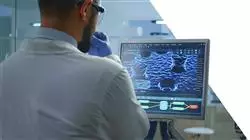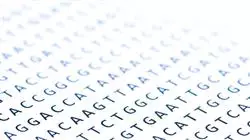University certificate
The world's largest faculty of medicine”
Introduction to the Program
With TECH Global University, you will get up to date on advances in Bioinformatics and Big Data applied to Medicine"

In recent years, the development of bioinformatics has made it possible to achieve great scientific advances in various sectors such as agriculture, food and medicine. It is in this field where the incorporation of new techniques and computer processing have allowed the collection of a large amount of biological data, working with them and even creating a 3D model of the viral protein of the COVID-19 spike. All this not only leads to a better understanding of viral processes, but also to obtaining vaccines or specific drugs in less time.
Likewise, given the speed of mutation and transmission of diseases, the massive collection and analysis of clinical data will lead to more effective action, from prevention to cure. A reality of great interest for medical professionals who want to keep abreast of developments in this field. For this reason, TECH has created this program in Bioinformatics and Big Data in Medicine, developed by a team of professionals with extensive experience in this field.
A 100% online program, where the specialist will be able to delve dynamically into future trends in Bioinformatics computing, analysis techniques used in biomedical datasets or the different tools used from engineering in bioprocesses. All this, through a content with a theoretical-practical approach, complemented with multimedia teaching resources of excellent quality.
In addition, thanks to the Relearning method, the graduate will be able to progressively advance through the syllabus and reduce the long hours of study with the reiteration of key concepts during the course of this program.
In this way, this educational institution offers the specialist the most relevant and current information on Bioinformatics and Big Data in Medicine through a flexible program, which can be accessed whenever and wherever they want. All you need is an electronic device (computer, tablet or cell phone) with an Internet connection to access, at any time, the syllabus hosted in the Virtual Campus. An ideal option for those who seek to balance the most demanding responsibilities with a quality university program.
With this program, you will learn about the use of Machine Learning algorithms in public health and the existing problems with data privacy"
This Postgraduate diploma in Bioinformatics and Big Data in Medicine contains the most complete and up-to-date scientific program on the market. Its most notable features are:
- This Postgraduate Diploma in Bioinformatics and Big Data in Medicine contains the most complete and up-to-date scientific program on the market. Its most notable features are:
- The development of practical cases presented by experts in bioinformatics and databases
- The graphic, schematic, and practical contents with which they are created, provide practical information on the disciplines that are essential for professional practice
- Practical exercises where self-assessment can be used to improve learning
- Its special emphasis on innovative methodologies
- Theoretical lessons, questions to the expert, debate forums on controversial topics, and individual reflection assignments
- Content that is accessible from any fixed or portable device with an Internet connection
The Relearning system, used by TECH Global University, will help you to reduce the long hours of study and to easily learn key concepts"
The program’s teaching staff includes professionals from the sector who contribute their work experience to this educational program, as well as renowned specialists from leading societies and prestigious universities.
The multimedia content, developed with the latest educational technology, will provide the professional with situated and contextual learning, i.e., a simulated environment that will provide immersive education programmed to learn in real situations.
This program is designed around Problem-Based Learning, whereby the professional must try to solve the different professional practice situations that arise during the course. For this purpose, the student will be assisted by an innovative interactive video system created by renowned and experienced experts.
This Postgraduate diploma provides you with the most relevant biomedical, DNA and protein databases in the field of medical research.

This program provides you with the most relevant biomedical, DNA and protein databases in the field of medical research.
Syllabus
The syllabus of this program has been developed by specialists in Biomedicine and Bioinformatics, with extensive knowledge of this field. Thanks to their contribution, the professional will be able to update on Bioinformatics computing, databases in Biomedicine and massive processing of health data. All this, with an innovative multimedia teaching material, which forms a library of resources that can be accessed at any time of the day, from an electronic device with an Internet connection.

A syllabus that will introduce you to Bioinformatics computing through multimedia pills and dynamic teaching resources"
Module 1. Computation in Bioinformatics
1.1. Central Tenet in Bioinformatics and Computing. Current State
1.1.1. The Ideal Application in Bioinformatics
1.1.2. Parallel Developments in Molecular Biology and Computing
1.1.3. Dogma in Biology and Information Theory
1.1.4. Information Flows
1.2. Databases for Bioinformatics Computing
1.2.1. Database
1.2.2. Data management
1.2.3. Data Life Cycle in Bioinformatics
1.2.3.1. Use
1.2.3.2. Modifications
1.2.3.3. Archive
1.2.3.4. Reuse
1.2.3.5. Discarded
1.2.4. Database Technology in Bioinformatics
1.2.4.1. Architecture
1.2.4.2. Database Management
1.2.5. Interfaces for Bioinformatics Databases
1.3. Networks for Bioinformatics Computing
1.3.1. Communication Models. LAN, WAN, MAN and PAN Networks
1.3.2. Protocols and Data Transmission
1.3.3. Network Topologies
1.3.4. Datacenter Hardware for Computing
1.3.5. Security, Management and Implementation
1.4. Search Engines in Bioinformatics
1.4.1. Search Engines in Bioinformatics
1.4.2. Search Engine Processes and Technologies in Bioinformatics
1.4.3. Computational Models: Search and Approximation Algorithms
1.5. Data Display in Bioinformatics
1.5.1. Displaying Biological Sequences
1.5.2. Displaying Biological Structures
1.5.2.1. Visualization Tools
1.5.2.2. Rendering Tools
1.5.3. User Interface in Bioinformatics Applications
1.5.4. Information Architectures for Displays in Bioinformatics
1.6. Statistics for Computing
1.6.1. Statistical Concepts for Computing in Bioinformatics
1.6.2. Use Case: MARN Microarrays
1.6.3. Imperfect Data. Statistical Errors: Randomness, Approximation, Noise and Assumptions
1.6.4. Error Quantification: Precision and Sensitivity
1.6.5. Clustering and Classification
1.7. Data Mining
1.7.1. Mining and Data Computing Methods
1.7.2. Infrastructure for Data Mining and Computing
1.7.3. Pattern Discovery and Recognition
1.7.4. Machine Learning and New Tools
1.8. Genetic Pattern Matching
1.8.1. Genetic Pattern Matching
1.8.2. Computational Methods for Sequence Alignments
1.8.3. Pattern Matching Tools
1.9. Modelling and Simulation
1.9.1. Use in the Pharmaceutical Field: Drug Discovery
1.9.2. Protein Structure and Systems Biology
1.9.3. Available Tools and Future
1.10. Collaboration and Online Computing Projects
1.10.1. Grid Computing
1.10.2. Standards and Rules Uniformity, Consistency and Interoperability
1.10.3. Collaborative Computing Projects
Module 2. Biomedical Databases
2.1. Biomedical Databases
2.1.1. Biomedical Databases
2.1.2. Primary and Secondary Databases
2.1.3. Major Databases
2.2. DNA Databases
2.2.1. Genome Databases
2.2.2. Gene Databases
2.2.3. Mutations and Polymorphisms Databases
2.3. Protein Databases
2.3.1. Primary Sequence Databases
2.3.2. Secondary Sequence and Domain Databases
2.3.3. Macromolecular Structure Databases
2.4. Omics Projects Databases
2.4.1. Genomics Studies Databases
2.4.2. Transcriptomics Studies Databases
2.4.3. Proteomics Studies Databases
2.5. Genetic Diseases Databases. Personalized and Precision Medicine
2.5.1. Genetic Diseases Databases
2.5.2. Precision Medicine. The Need to Integrate Genetic Data
2.5.3. Extracting Data from OMIM
2.6. Self-Reported Patient Repositories
2.6.1. Secondary Data Use
2.6.2. Patients' Role in Deposited Data Management
2.6.3. Repositories of Self-Reported Questionnaires. Examples
2.7. Elixir Open Databases
2.7.1. Elixir Open Databases
2.7.2. Databases Collected on the Elixir Platform
2.7.3. Criteria for Choosing between Databases
2.8. Adverse Drug Reactions (ADRs) Databases
2.8.1. Pharmacological Development Processes
2.8.2. Adverse Drug Reaction Reporting
2.8.3. Adverse Reaction Repositories at European and International Levels
2.9. Research Data Management Plans. Data to be Deposited in Public Databases
2.9.1. Data Management Plans
2.9.2. Data Custody in Research
2.9.3. Data Entry in Public Databases
2.10. Clinical Databases. Problems with Secondary Use of Health Data
2.10.1. Medical Record Repositories
2.10.2. Data Encryption
Module 3. Big Data in Medicine: Massive Medical Data Processing
3.1. Big Data in Biomedical Research
3.1.1. Data Generation in Biomedicine
3.1.2. High-Throughput Technology
3.1.3. Uses of High-Throughput Data. Hypotheses in the Age of Big Data
3.2. Data Pre-Processing in Big Data
3.2.1. Data Pre-Processing
3.2.2. Methods and Approaches
3.2.3. Problems with Data Pre-Processing in Big Data
3.3. Structural Genomics
3.3.1. Sequencing the Human Genome
3.3.2. Sequencing vs. Chips
3.3.3. Variant Discovery
3.4. Functional Genomics
3.4.1. Functional Notation
3.4.2. Mutation Risk Predictors
3.4.3. Association Studies in Genomics
3.5. Transcriptomics
3.5.1. Techniques to Obtain Massive Data in Transcriptomics: RNA-seq
3.5.2. Data Normalization in Transcriptomics
3.5.3. Differential Expression Studies
3.6. Interactomics and Epigenomics
3.6.1. The Role of Cromatine in Gene Expression
3.6.2. High-Throughput Studies in Interactomics
3.6.3. High-Throughput Studies in Epigenetics
3.7. Proteomics
3.7.1. Analysis of Mass Spectrometry Data
3.7.2. Post-Translational Modifications Study
3.7.3. Quantitative Proteomics
3.8. Enrichment and Clustering Techniques
3.8.1. Contextualizing Results
3.8.2. Clustering Algorithms in Omics Techniques
3.8.3. Repositories for Enrichment: Gene Ontology and KEGG
3.9. Applying Big Data to Public Health
3.9.1. Discovery of New Biomarkers and Therapeutic Targets
3.9.2. Risk Predictors
3.9.3. Personalized Medicine
3.10. Big Data Applied to Medicine
3.10.1. Potential for Diagnostic and Preventive Assistance
3.10.2. Use of Machine Learning Algorithms in Public Health
3.10.3. The Problem of

A program that will show you the current trends in Big Data applied to medicine and its usefulness in disease prevention"
Bioinformatics and Big Data in Medicine
Big data in medicine is an emerging tool that uses data storage, processing and analysis technologies to improve clinical care and medical research. In medical practice, big data enables the collection and analysis of large amounts of information to identify patterns of health and disease, and to improve the quality of healthcare.
One of the biggest challenges is ensuring data privacy and security. It also requires personnel trained in data analysis, and the greater the volume of data, the greater the complexity in handling it....
Applications of big data in medicine
Identifying patterns and trends: Collecting and analyzing large amounts of data can help in identifying patterns and trends in health and disease, which in turn can help in disease prevention or treatment. Early diagnosis: Analysis of large amounts of data can help in early identification of diseases and with that, achieve early intervention and delay the negative effects of diseases. Personalization of treatments: Collecting data on individual patients can help in the personalization of specific treatments, which in turn can improve efficacy and reduce side effects. Medical research: Big data can help identify and evaluate new treatments and therapies through data analysis and outcome comparison.
This specialized program is designed for professionals or students in the medical field. Enroll right now and start your specialization and delve into Big data in medicine is an increasingly important tool for healthcare and medical research, as it enables the collection and analysis of large amounts of data to identify patterns and trends in health and disease, improve the quality of clinical care, and develop new therapies and treatments.







